These FAQs and answers are here to help, but please feel free to contact PLR Ltd with any queries you have.
What is ‘land remediation’ and do you offer this service? Land remediation is the process by which contaminated or marginal land is restored to productive use. You can see more about it here. PLR Ltd deal with remediation of land blighted by invasive weeds.
What are invasive plants? Some non-native plants have been introduced to the UK. Not all cause a problem, but a few become ‘invasive’ and take over an area. They do this by being better adapted for their environment than the other species growing in the area; they may, for example, grow bigger or faster or more aggressively. Very often there are no natural predators (disease, temperature, herbivores, etc). As a result, native species are often crowded out and the invasive plants take over, further upsetting the local ecological balance. Japanese knotweed is listed by the World Conservation Union as one of the world’s 100 worst invasive species
What is Japanese knotweed? Japanese knotweed is a large herbaceous plant which dies back in the winter and regrows in the spring and summer. Native to eastern Asia in Japan, China and Korea, it has been introduced to the British Isles; because it has established itself so successfully, it has been classified as an invasive species. The Latin name for Japanese knotweed is Fallopia japonica, and it’s also known as Polygonum cuspidatum Reynoutria japonica. In Chinese medicine it is known as Huzhang, and the Japanese name for it is itadori Other names include:
- American bamboo
- donkey rhubarb
- elephant ears
- fleeceflower
- Hancock’s curse
- Himalayan fleece vine
- Japanese bamboo
- Mexican bamboo
- monkey fungus
- monkeyweed
- pea shooters
- sally rhubarb
(By the way, despite the names, it is not bamboo or rhubarb.) Where does Japanese knotweed grow? Japanese knotweed will grows in all manner of places! Because it has such strong growth in a season and no competition, it can be found in gardens, on building sites, by rail cuttings, lining rivers and canals, on indiustrial parks – you name it, you’ll probably find it there! Because a new crop can grow from just a small piece of rhizome, much of its spread is probably via topsoil movement or construction traffic. Under the provisions made within the Wildlife and Countryside Act 1981, it is now an offence to cause Japanese knotweed to grow in the wild.
What are the laws governing Japanese knotweed? Because of the ecological impact and the vast sums of money spent on its eradication, in England and Wales it is an offence under section 14(2) of the Wildlife and Countryside Act 1981 to ‘plant or otherwise cause to grow in the wild’ any plant listed in Schedule nine, Part II to the Act – needless to say, this includes Japanese knotweed. In Scotland, the Wildlife and Natural Environment (Scotland) Act 2011 states that is an offence to either intentionally or unintentionally spread Japanese knotweed (or other non-native invasive species). It is also classed as ‘controlled waste’ throughout Britain, meaning it requires disposal at licensed landfill sites. This doesn’t just mean large amounts; it also includes any knotweed found in your garden. Japanese knotweed goes through an annual cycle, so it depends on what time of the year you’re looking. There are more details on our Japanese Knotweed Identification page, but here it is in brief:
Spring growth
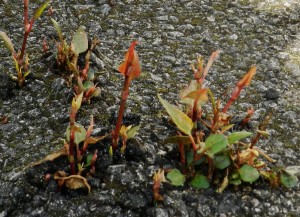
The earlier shoots look a bit like dark asparagus tips! Soon, purply-green leaves unfurl:
Summer foliage
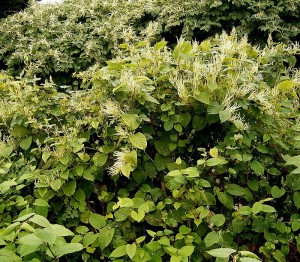
The summer growth is attractive to look at, but it spreads very quickly and can grow 2-3 metres high and crowd out other species. The spade/heart shaped leaves are broad and thin and a bright to mid green and pretty clusters of white flowers bloom. The stems of the knotweed are hollow (like bamboo). They are green with a purple mottle.
Winter remains
Eventually the leaves brown and fall off. The rest of the growth browns and dies back a bit. Next year, new shoots will grow up through those remnants.
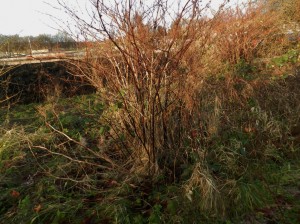
Why does having Japanese knotweed on my land matter? In short, it matters because Japanese knotweed can damage your property. This is because its root system is amazingly invasive – it grows strongly and over a wide area. The roots can damage all manner of things; examples include:
- architectural sites
- buildings
- canal sides
- concrete foundation
- flood defences
- roads
- paved areas
- pavements
- retaining walls
It can also block water ways meaning, for example, that water traffic is hindered and that flood water can’t flow away
What if I just leave it? It is an offense in law to ignore the knotweed or to quietly take it to the tip.
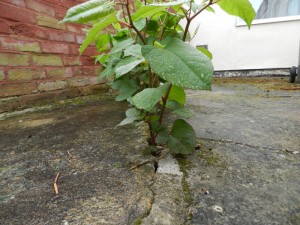
If you discover Japanese knotweed on your land, you must take steps to eradicate it – contact your local Department of the Environment or give us a call. If you do leave it, it will spread… and it can cause a lot of structural damage to patios, walls and buildings. Even worse, you will have real trouble selling it, as mortgage companies are unlikely to grant mortgages if Japanese knotweed is present.
How can you get rid of it for me?
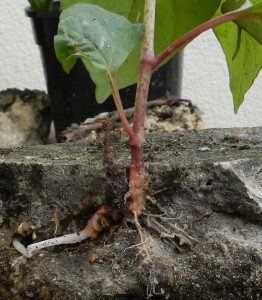
Japanese knotweed has a large underground network of roots (rhizomes). To eradicate the plant the roots need to be killed.
It does depend on your circumstances as to the approach we take, but we can either clear the knotweed (or other invasive plants) in situ, or by taking the affected soil away with us and dealing with it in designated sites:
In situ in brief
In situ stem injection eradication: Stem injection is suitable for use in areas where sensitivity towards the immediately surrounding vegetation is necessary.
Aquatically approved in situ herbicidal eradication: This method is approved by the Environment Agency for use adjacent to water courses. (Click here for in situ details)
Instant eradication in brief
We offer:
- Dig and dump eradication
- Soil screening
- Cell burial
- On site stock pile/relocation
- Geotextile non-permeable membranes
We are Environmental Agency approved and fully licensed controlled waste carriers, so you can be sure your land will be cleared. (See details here of the various ‘instant’ options)
If you come to clear our knotweed, will people know? I am worried about word spreading and my land / property value falling!
Don’t worry! Unlike some companies who emblazon ‘Knotweed Eradication Services’ and similar over their vehicles and boarding, we believe in discretion! Yes, we have van with logos, but people won’t know what it is about.
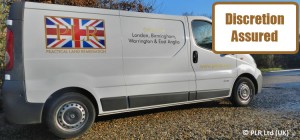
Do you offer CPD certifed training? Yes, we do – on all invasive weeds, with special emphasis on Japanese knotweed.
We prefer to run bespoke training for your company – so call or email us in the first instance.
Details of what we cover are here.
